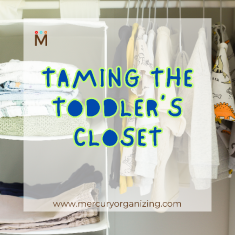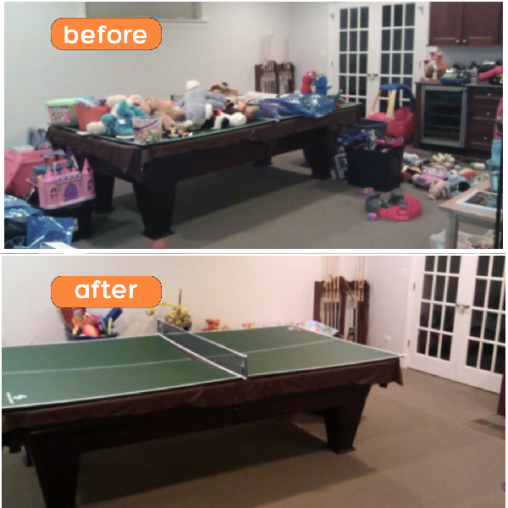Taming the Toddler Tornado: Transforming Your Home to Reclaim Calm

Preparing for the Organizing Project
The key to a successful decluttering session depends on your strategic planning. Here's what you need to do before diving in
Select Your Schedule
Choose a time when you'll have uninterrupted focus. Weekends or nap times can be ideal. Inform everyone in the household about the decluttering mission, especially older siblings who might be able to lend a hand (or at least stay out of the way!).
Distract Your Playful Toddler:
Toddlers have a talent for turning decluttering efforts into epic games of hide-and-seek with sorting piles. Plan a playdate for your little one, enlist the help of a babysitter, or set up a captivating activity in another part of the house to keep them occupied while you work your magic.

Gather Supplies:
Just like any good soldier, you need the right tools for the job. Stock up on large bags for donations and trash, laundry baskets for separating clean and dirty clothes, and storage bins of various sizes for organizing toys. Label the donation and trash bags clearly to avoid any confusion later.
Taming the Toddler's Wardrobe
Now that you're prepped and ready, let's tackle the overflowing closets and drawers.
Be a Diligent Inspector
Be ruthless! Sort through your toddler's clothes, discarding anything with stains, rips, or excessive wear. Don't be sentimental about clothes with holes; they're not doing your child any favors, and they're taking up valuable storage space. Gently used items in good condition can be donated to a local charity or children's shelter.
Does it measure up?
Organize clothes by size. Create separate piles for "keep," "future growth," and "donate." Be realistic about your child's growth spurts. While it's tempting to hold onto everything "just in case," overstocking on clothes in sizes they won't fit into for months creates clutter and makes getting dressed a frustrating experience for both of you.
Declutter the toy bins:
- Missing in Action: broken toys, puzzles with missing pieces, and building sets with major losses.
- Outgrown: Rattles, teethers, push toys, and simple shape sorters.
- Too Many of a Good Thing: Excess toy cars, dolls, or plastic food sets.
- Sensory overload: toys with loud noises, flashing lights, or confusing features.
- Faded Fandoms: Character toys from forgotten shows or movies.
- Incomplete Sets: board games or art sets with missing pieces.
- Freebie Frenzy: Happy Meal Toys and Promotional Giveaways.
- Get your little one involved! Let them pick a couple of toys for donation and help them understand why you're making space for new adventures!
Keeping for Sentimental Reasons?
We all love those special outfits—the first birthday one, the one for that first walk. It's tempting to keep them all, like holding onto happy memories. However, storage space is limited, and clothes can get damaged over time. Don't let these precious pieces get forgotten in a box! Instead, pick a few that truly bring a smile to you and your child's faces. Donate the rest; it's a generous way to give them a new life, and remember, the real treasures are the moments themselves, not the clothes.

Maximize Storage with Shelves
Double-hanging rods are your best friend in small closets. Utilize shelves or clear bins for folded clothes like pajamas, socks, and T-shirts. This allows for easy categorization and visibility, making it easier for your child to find what they need.
Accessibility is key.
Store everyday clothes within your toddler's reach. This not only fosters a sense of independence as they learn to dress themselves, but it also reduces the morning scramble for missing socks or favorite shirts.
Labeling makes life easier.
Use colorful labels or pictures on bins and shelves to help your child easily identify their clothes, especially if they haven't yet mastered reading. This not only saves time but also encourages them to take ownership of their belongings and put things away after they're done.
Keeping Playtime Fun Without the Mess
Toys are another battleground in the war against toddler clutter. Here are some strategies to keep the toy box from overflowing.
Out with the Old, In with the New
Donate toys that are outgrown or no longer function. Broken toys can be tossed, but consider if there's an opportunity for a repair project you can do with your child. This can be a fun learning experience and teach them valuable lessons about taking care of their belongings.
Encourage personal development
Group similar toys together in bins. This not only promotes organization but also encourages imaginative, themed play. For example, have a bin for building blocks, another for cars and trucks, and another for dolls and stuffed animals.

Keep Funtime Fresh
Keep a selection of toys readily available on shelves or in a designated play area. Store the rest out of sight in a closet, on higher shelves, or in a separate playroom altogether Rotate the clothes and toys periodically, bringing out a fresh selection every few weeks. This keeps playtime fresh and engaging for your child, preventing them from getting bored with the same old toys. And have clothes ready for their next growth spurt.
Building a Team Effort and Long-Term Strategy
Decluttering with toddlers isn't a one-time battle; it's an ongoing learning process. By keeping up with these tips, you’ll make a collaborative effort and establish sustainable habits.
Empower Your Little Team Player
While you'll be making the final decisions, involve your child in the decluttering process. Let them choose a few toys to put away in a storage bin and others to keep out to play with. This fosters a sense of responsibility and teaches them the importance of tidying up.
Make Tidying Up a Game
Turn cleaning into a fun activity. Play upbeat music and have races to see who can put away the most toys first. Use positive reinforcement, such as praise and stickers, for a job well done.
Lead by Example
Kids learn best by observing their parents. Develop good habits for yourself by putting away your belongings and keeping common areas tidy. Let them see you do the tidying up, and they may even get up to help you on their own.
Make Regular Decluttering a Habit
Spring cleaning comes once a year, but if you integrate decluttering into your routine year-round, you will save spring cleaning for those heavy-duty projects. Dedicate a short amount of time each week or month to go through clothes and toys, keeping the clutter from accumulating again.
The Rewards of a Calm and Organized Home
By implementing these strategies, you can transform your home from a chaotic playroom into a haven of organization and peace. The benefits go beyond just a tidy space.
Reduced Stress:
Clutter can be a major source of stress for both parents and children. A well-organized environment fosters a sense of calm and allows everyone to focus on more important things.

More Playtime, Less Cleanup
Having a designated space for everything means less time spent searching for lost toys and more time spent enjoying quality playtime with your child.
Teaching Valuable Life Skills
By involving your child in the decluttering process and encouraging them to keep their space tidy, you're teaching them important life skills like organization, responsibility, and decision-making.
Making Clothes Easy to Find
Now, make getting dressed a breeze: Use the lower hanging rods with kid-sized hangers, and use labeled bins or drawers for shirts, pants, and PJs. This simple system helps your little one find everything easily, fostering independence at playtime (dressing time)
Remember, taming the toddler tornado may feel like a marathon, not a sprint. Be patient, celebrate your successes, and most importantly, have fun with the process! With a little planning and effort, you can create a home that fosters both your child's development and your sanity.
To sum things up, we all know that living with a toddler can be challenging when it comes to clutter. Remember, you're not alone—many parents face the same situation! Embrace the chaos, and remember that perfection isn't necessary. Just keep trying. Follow these simple tips to create a peaceful environment for you and your child. Organization isn't just about cleanliness—it's about maintaining your sanity and supporting your child's development. So, grab some bins, play some music, and reclaim peace and calm in your home






